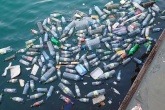PFAS cleanup could cost Europe up to €2 Trillion
Le Monde reveals that widespread PFAS contamination could result in staggering economic costs, compounding the environmental and health burdens of plastic pollution.
 As more light is shed on the severe health and environmental impacts of plastic pollution, Le Monde and its partners have released a new report on the staggering economic cost of plastic contamination and the industrial lobbying efforts against regulation.
As more light is shed on the severe health and environmental impacts of plastic pollution, Le Monde and its partners have released a new report on the staggering economic cost of plastic contamination and the industrial lobbying efforts against regulation.
The report focuses on per- and polyfluoroalkylated substances (PFAS), synthetic compounds often referred to as “forever chemicals”. Known for their water-repellent, non-stick, and temperature-resistant properties, PFAS have been widely adopted across industries, including consumer goods, chemicals, aerospace, construction, electronics, and energy.
However, growing evidence has highlighted the consequences of their indestructible nature. PFAS are not naturally degradable, meaning they persist in the environment and have spread globally, contaminating nearly all living organisms, including the human bloodstream.
Warnings about the harmful effects of exposure to these chemicals are intensifying, with plastics researchers increasingly linking health crises to plastic chemicals and microplastics.
Janek Vähk, Zero Pollution Policy Manager at Zero Waste Europe, discussed the spread of PFAS: “Our research across five countries shows significant contamination in areas around waste incinerators. These "forever chemicals" are extraordinarily resistant to breakdown and cannot be destroyed at standard incineration temperatures. Ironically, the industry's touted solution—incineration—is not mitigating the problem but worsening it.”
The cost of contamination
According to Le Monde, addressing PFAS contamination could cost between €95 billion and €2 trillion over the next 20 years, with the highest figures being considered “the most realistic”. This sum reflects the cost of cleaning up contaminated sites, with Le Monde estimating at least 23,000 such sites across Europe.
These estimates do not include the impact of PFAS on healthcare systems or the myriad other negative externalities that are difficult to quantify.
To meet current legal standards, PFAS cleanup would focus on high-priority sites, such as landfills, contaminated soil, and drinking water production units. Specific actions to achieve this were highlighted in the report, including:
- Treating landfill leachate, which is concentrated with PFAS, would cost €1 million per kilogram removed
- Incorporating advanced filtration techniques into wastewater treatment would require at least €45 billion annually
- Burning sewage sludge to destroy PFAS could cost €20 billion annually
- Cleaning up 1,800 contaminated soil sites in Europe would cost at least €3 billion per year
Moreover, Le Monde warns that the annual cost of cleanup would need to be paid “in perpetuity” as long as PFAS remain unregulated.
If the companies responsible for the pollution are not held accountable, each European household could be required to pay €450 annually to clean up the environment surrounding them.
PFAS regulation
In February 2023, four European Union member states (Germany, Denmark, the Netherlands, and Sweden) proposed a ban on the manufacture, placing on market, and use of all PFAS within the EU. If successful, this ban would come into force in 2026.
Despite the long transition periods added into the proposal, the draft restrictions have been met with intense lobbying efforts aimed at preventing the ban on PFAS.
In a 2023 investigation, Le Monde reviewed over 1,200 documents from the European Commission and the European Chemicals Agency (ECHA), to uncover a vast lobbying campaign led by about 100 organizations and 30 major chemical companies.
Commenting on Le Monde’s findings, Dorota Napierska, Toxic-Free Circular Economy Policy Officer at Zero Waste Europe, said: “PFAS pollution is not just a public health crisis but a stark example of industrial lobbying and systemic inaction. While industries spend millions lobbying to protect profits, the public shoulders the far greater cost.”
A comprehensive ban on PFAS has not yet been enacted in the UK, though additional restrictions, such as limiting the use of PFAS-containing firefighting foams, were proposed in 2023.
Additionally, a limit of 100 nanograms per liter for 48 different PFAS compounds found in drinking water has come into force from January 2025.







